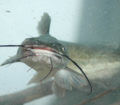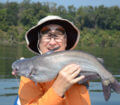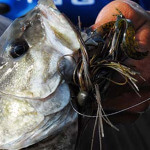Editor’s Note: The last Friday in April, 2018, I received unbelievable pictures from my friend, fishing guide Tony Adams in Eufaula, Alabama. Tony sent me pictures of giant shellcrackers (redear sunfish), crappie that were longer than a 5-gallon bucket, and catfish that weighed from 10 to 30 pounds. “This is it!” I told Adams when I called him. “Now’s the chance to catch the Lake Eufaula trifecta of delicious-eating fish – shellcrackers, crappie and cats. I’ll leave on Monday, and we’ll slay them.” But I forgot what a good friend of mine once told me many years ago. “A fishing report is history and tells you what’s happened yesterday. But it in no way influences what will be happening tomorrow or next week.”
My friend, Lake Eufaula fishing guide Tony Adams, isn’t a one-trick pony. I’d fished with him last summer, and we’d been amazingly successful. As we motored out to fish for shellcrackers last Monday April 30, Tony said, “Would you like to have some catfish to eat?” I looked at him, smiled and said, “Of course.” Then he said, “Okay, we’ll put out 75 jugs on the way to go crappie fishing, and we should catch from 150 to 200 pounds of cats, while we’re crappie fishing.”
 So, on the way to fish for shellcrackers on Monday afternoon, we put out 75 Gatorade jugs, each with 40-60 feet of line and a No. 6 steel circle hook baited with either big chunks of mullet or skipjack herring on it. When I asked Adams, “Why do you use mullet?” he explained that, “Mullet is a saltwater fish that’s very smelly and stinky when it gets in warm water. Because catfish are drawn to anything that has a strong odor, I’ve found that mullet makes an excellent catfish bait. Another reason I use mullet is they’re very inexpensive bait. Two packages of mullet will bait about 24 jugs.”
So, on the way to fish for shellcrackers on Monday afternoon, we put out 75 Gatorade jugs, each with 40-60 feet of line and a No. 6 steel circle hook baited with either big chunks of mullet or skipjack herring on it. When I asked Adams, “Why do you use mullet?” he explained that, “Mullet is a saltwater fish that’s very smelly and stinky when it gets in warm water. Because catfish are drawn to anything that has a strong odor, I’ve found that mullet makes an excellent catfish bait. Another reason I use mullet is they’re very inexpensive bait. Two packages of mullet will bait about 24 jugs.”
I asked, “How do you get the skipjack herring, because those big herring are often hard to catch?” Adams answered, “When I’m fishing for crappie with either small minnows or small jigs, a school of herring often will come by, and I’ll start catching them. Instead of throwing them back, I’ll put them in a plastic bag in my ice chest. Then when I get home, I’ll cut the herring into large chunks and dry freeze them. When most people freeze fish, they put water in with the fish that they freeze to keep the air from getting to the fish and freezer burning them. But by dry freezing (adding no water to the packages) the herring, the meat stays much firmer and fresher when I bait for cats. Sometimes if I keep the herring very long, they’ll get a little bit of freezer burn, but that doesn’t seem to affect the number of cats I catch on these baits.”
Adams also had put orange-painted Gatorade jugs in the same racks that the Gatorade is delivered in to the stores. I noticed that the orange paint was on the inside of the Gatorade bottles instead of on the outside. “How and why do you put that orange paint on the inside of the Gatorade jugs?” I asked Adams. Adams smiled and said, “It’s simple. I buy a pint or a quart of liquid orange paint. In years past, when I spray painted my jugs, I noticed that the paint often would crack and peel over time, and a lot of paint was required to spray paint the number of jugs I fished with each year. However, by using liquid paint, I can pour the paint in the Gatorade jugs, fill them halfway up, put the lid on and shake the jug. Then I pour the paint back in the container that I’ve bought it in and stand the jug upside down, so that any remaining paint will come out the mouth of the jug. After the paint dries inside the jugs, I’ll put the lids back on them.”
 Adams’ Gatorade catfish jugs also have another unusual feature. He uses strips of reflective tape on the tops and the bottoms of the jugs. Adams says, “When I’m catfishing at night, I use a spotlight to keep up with my jugs. If the jugs are on their sides and facing me, I quickly and easily can spot the jugs, because of the reflective tape on their caps. If the jug has a catfish on the end of the line, it’ll pull the cap under the water, and the bottom of the jug will be standing up with its reflective tape showing.”
Adams’ Gatorade catfish jugs also have another unusual feature. He uses strips of reflective tape on the tops and the bottoms of the jugs. Adams says, “When I’m catfishing at night, I use a spotlight to keep up with my jugs. If the jugs are on their sides and facing me, I quickly and easily can spot the jugs, because of the reflective tape on their caps. If the jug has a catfish on the end of the line, it’ll pull the cap under the water, and the bottom of the jug will be standing up with its reflective tape showing.”
I’ve jug fished most of my life at various times. I’ve always fished with lines 3-6 feet deep, and I’ve usually caught quite a few eating-size catfish. So I asked Adams, “Why do you put lines down 40 feet and 60 feet on the jugs you fish?” Adams informed me that he was fishing for big cats that usually weigh from 10 to 60 pounds. “I’ve learned that big cats generally hold where they find the most food – either on mussel beds or the edge of the main river channel. Most of the mussel beds on Lake Eufaula are in about 35-45 foot deep water. So, I’ll set my shallow lines in 20-40 foot water and my deep lines in 50-60 foot water. I use big baits and big hooks, because I’m fishing for big cats.”
I also noticed that the monofilament line that Adams used was relatively small. I would have expected Adams to be fishing with heavy line – 60-pound test or more. When I asked Adams why he used small line, he explained, “Catfish like to hold around structure. Older and smarter catfish probably have been hooked before. They know that if they get to the structure and hang the line up in the structure, they either can break the line or pull free of the hook. Out of my 75 jugs that I put out, I’ll often have as many as five to 10 jugs up in the structure. By using 40-pound-test monofilament line, when the jug gets hung in the structure, I can take hold of the jug and use the power of my motor to break off the line or pull the hook free. This way, I only lose a hook and a line. I don’t lose my jug.”
 I wanted to know how Adams learned all his jug fishing secrets, and he explained, “Simply by trial and error. I’ve been jug fishing for catfish most of my life, and I’ve learned where and how to find the bigger cats and catch them down here on Lake Eufaula. I’ve also learned that if a person wants to fish just for cats for 4 hours, if we stay with the jugs, we usually can catch 200-300 pounds of cats in 4 hours. Once a jug goes down, we go straight to it and don’t give the cats time to get hung-up in the structure.”
I wanted to know how Adams learned all his jug fishing secrets, and he explained, “Simply by trial and error. I’ve been jug fishing for catfish most of my life, and I’ve learned where and how to find the bigger cats and catch them down here on Lake Eufaula. I’ve also learned that if a person wants to fish just for cats for 4 hours, if we stay with the jugs, we usually can catch 200-300 pounds of cats in 4 hours. Once a jug goes down, we go straight to it and don’t give the cats time to get hung-up in the structure.”
You can contact Tony Adams at 334-688-7505, or tony.adams@marvins.com. He also has Facebook page https://www.facebook.com/tony.adams.5477.
While in Eufaula, I stayed at Lakepoint Resort in the Alabama State Park (http://www.alapark.com/lakepoint-state-park), where the rooms have views of the lake, and the food is delicious. Contact the sales director, Sone Kornegay, at 334-687-8011 to learn more. Email pam@alabamablackbeltadventures.org to learn more about Alabama Black Belt Adventures which cover fishing at Lake Eufaula.
To learn more about fishing for catfish, go to http://amzn.to/W900eu and for crappie, https://johninthewild.com/books/#crappie. For free copies of “The Catfish Catcher’s Cookbook” and “The Crappie Catcher’s Cookbook,” visit https://johninthewild.com/free-books.










